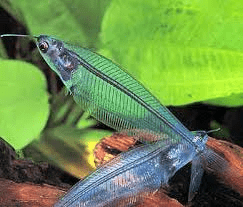
Common name: Glass Catfish
Scientific name: Kryptopterus Bicirrhis
Average Adult Fish Size: 5 inches / 12 cm
Place of Origin: Type locality is given simply as ‘Java, Indonesia’, and this species is currently understood to occur throughout much of Southeast Asia including major river systems in Thailand, Laos, Cambodia, Vietnam and Peninsular Malaysia plus the Greater Sunda Islands of Sumatra, Borneo and Java.
It’s been extensively recorded from the Mekong, Chao Phraya, Batang Hari, Rajang and Kapuas rivers plus numerous smaller drainages across this range.
Typical Tank setup: Décor is relatively unimportant although this species prefers weakly-lit conditions and may become skittish in the absence of cover.
Do not add introduce it to a biologically immature aquarium as it can be susceptible to swings in water chemistry.
Recommended Minimum Aquarium Capacity: 55 gallon / 240 litre
Compatibility: Generally peaceful though it may predate on smaller fishes and is somewhat timid so does not compete well with much larger, robust or otherwise boisterous species.
Peaceful, comparably-sized cyprinids, loaches and other catfishes perhaps constitute the best options but be sure to research your choices thoroughly prior to purchase.
K. bichirris is gregarious and tends to form schools so ideally four or more specimens should be purchased.
Temperature: 69 – 82 Deg. F / 20 – 28 Deg. C
Water chemistry: pH 6.0 – 7.5
Feeding: Chiefly a predator feeding on crustaceans, invertebrates and smaller fishes in nature, although there should be no need to use such live foods in captivity.
Offer a varied diet comprising sinking dried foods, live and frozen bloodworm, Tubifex, etc., and perhaps the occasional small earthworm.
Sexing: Adult males should appear noticeably slimmer than females.
Breeding: Unknown.
Additional Information: This species is uncommon in the aquarium trade although it’s name has been widely misapplied to the congener K. vitreolus in older literature.
These two are easily told apart since K. bichirris does not possess a transparent body in life.


Related Posts
Croaking Gourami – Trichopsis vittatus
Paradise Fish – Macropodus opercularis
Schubert’s Barb – Barbus Semifasciolatus